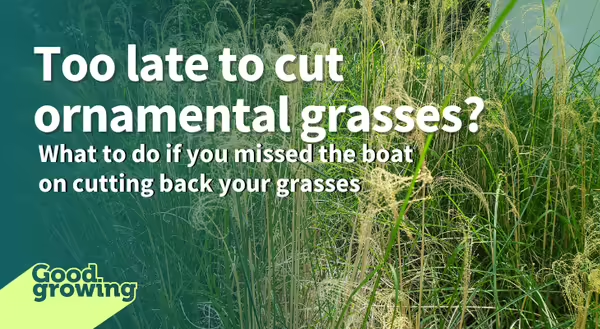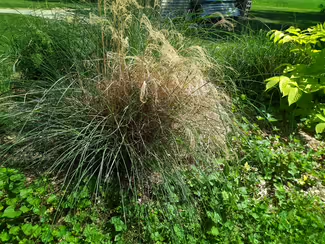
Grass Faux Pas
Every day I drive up to my house, I am confronted with the neglect of my landscape. Admittedly, I did not cut back my ornamental grasses this spring. At a Memorial Day pool party, the conversation turned to neighbors who don’t cut back their grasses. Everyone agreed, uncut ornamental grasses drove them crazy! I slunk low in my patio chair and shot my wife a glance that read, “Don’t give me away!”
Why do unpruned ornamental grasses stick in my conscience so much? It’s only a couple of grasses, right? Well, the former owner of our home must have loved ornamental grasses, because they are everywhere in my yard. No matter where you look right now, there are half-green, half-tan clumps of tall grass.
Methods for cutting back ornamental grass
I did a better job managing these grasses for the few previous springs we have been in our home. One year I borrowed a friend’s hedge trimmer, tied the grasses in a bundle, and cut at the base of the plant. The bundle is easy to carry and makes cleanup a breeze. The next year I burned all the grass. That was much more exciting, but if you’ve never burned prairie or grasses before, these fires burn quickly and intensely. I may have accidentally scorched part of the neighbor's lawn. (I apologized!) What’s the hang-up this year? These last months, I find myself either at the office or the baseball field helping coach two little league teams. The grasses will have to wait.
Does it hurt the grass to not cut it?
So what happens to the grass if we don’t cut it back in the spring? Nothing. It does not affect the overall health of the grass. Actually, once the new green leaf blades grow up they will mask last year’s foliage. Aside from the brown seed heads poking over the green growth, you won’t even notice.
Leaving ornamental grasses standing over the winter does help protect the growing points of the plant at the soil line from extremely cold temperatures. Grasses and other herbaceous plant stems also serve as habitat for beneficial insects and pollinators.
You may even argue that it is okay to just leave old growth every year. However, the accumulation of dead grass material can cause longer-term problems. And removing that old growth can be useful in getting rid of the debris and mimicking fire that created the vast North American prairies where many of our ornamental grasses developed.
Now what if it's too late?
At this point in early June do I plan to do anything with my ornamental grasses? I may take scissors and remove the most offending seed heads from last year. I also have plans to dig up some of the grasses and replace them with some woody shrubs and perennials. Cutting them back now at this point is probably not in the cards as they are just getting out of their ugly duckling phase and it would just prolong that.
Cutting the grass late in the season will trigger new growth from the base of the plant. After a few weeks of regrowth it should look good as new. There have been times when cutting ornamental grasses back in the summer it grows back shorter and sometimes the leaf tips are more rounded. Ornamental grasses also benefit from being divided every few years, especially as the crown expands outward sometimes leaving a dead center.
While I may hang my head somewhat in guilt for not cutting back my ornamental grasses, I remember sometimes the imperfections give us a new perspective. As Yogi Berra said, “If the world were perfect, it wouldn’t be.”
Good Growing Tip of the Week: Cutting or burning your ornamental grasses in the spring does have a benefit. When foliage is removed, spring growth will begin earlier. Old foliage left on the plant can delay the crown’s warming and subsequent growth by as much as 3 weeks.
Sign up for our emails! Want to get notified when new Good Growing posts are available? SIGN ME UP
MEET THE AUTHOR
Chris Enroth is a horticulture educator with University of Illinois Extension, serving Henderson, McDonough, Knox, and Warren counties since 2012. Chris provides horticulture programming with an emphasis on the home gardener, landscape maintenance personnel, and commercial landscapers. Additional responsibilities include coordinating local county Master Gardener and Master Naturalist volunteers - providing their training, continuing education, advanced training, seasonal events, and organizing community outreach programs for horticulture and conservation assistance/education. In his spare time, Chris enjoys the outdoors, lounging in the garden among the flowers (weeds to most).

